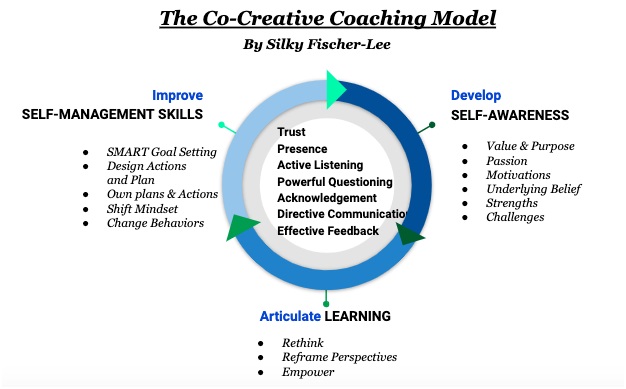A Coaching Model Created by Silky Fischer-Lee
(Executive Coach, SWITZERLAND)
 Introduction
Introduction
As organizations are dealing with constant changes in a highly complex and competitive market, many have fallen into a tendency to find quick answers. As an HR professional, working for a multinational company, I see today, more than ever, that we need transformational leadership to reshape our future.
Transformational leaders with high emotional intelligence can adapt to changes effectively, motivate, and engage people. This helps them to focus on the long-term vision. They are genuine and have a great awareness of themselves. They also hold themselves accountable for their actions with integrity. In many business organizations, coaching has been perceived as a consulting service that provides solutions to immediate needs, however, coaching is not a consulting service. It is “partnering with clients in a thought-provoking and creative process that inspires them to maximize their personal and professional potential (ICF, n.a.)”. Coaching is a great way to develop transformational leaders in organizations.
The Co-Creative Coaching Model that I created is a transformational Leadership Coaching which emphasizes the power of a co-creative partnership between the coach and leaders in a coaching process.
The Co-Creative Coaching Model
The Business Dictionary (n.a.) describes the term “co-creation” as a “business strategy focusing on customer experience and interactive relationship”. It also points out the benefits of co-creation as a strategy that enables “an active involvement from the customer to create a value-rich experience”. In short, co-creation brings rich customer experience, encourages customer’s active involvement, and creates value.
 My co-creative coaching model is based on the philosophy that acknowledges “we are resourceful and creative with energy, wisdom, ability, and genius waiting to be set in motion (ICA, 2018).”
My co-creative coaching model is based on the philosophy that acknowledges “we are resourceful and creative with energy, wisdom, ability, and genius waiting to be set in motion (ICA, 2018).”
This model was designed to create self-awareness, articulating learning, and improving self-management skills in a coaching process. It emphasizes building a strong partnership and trust between the coach and the client. It supports the client to enjoy a rich coaching experience, creating value in her or his personal and professional growth. The coach joins the client’s journey from right at the beginning and partners with the client throughout the process.
The model pragmatically provides the three critical paths to support the client in a journey of transformation.
Throughout the coaching process, the coach does the following:
Path 1: Develop Self-Awareness
Self-awareness is considered “the foundation of personal growth and success (ICA, 2018)” and the fundamental for transformational leadership.
In this first path, the coach’s focus is on creating and developing awareness of the client, exploring the client’s value, purpose, passion, motivations, strengths, and challenges. The coach builds trust with the client. Based on the relations built on trust, the coach and the client will explore underlying beliefs and what has contributed to creating the way the client thinks, feels, and behaves. The client will be able to clarify what the drivers are of their life and work.
“The Wheel of Life”, “StrengthsFinder”, journaling, or collecting feedback from family members, friends and colleagues are one of the useful tools that can be used to help the client develop their self-awareness.
Path 2: Articulate Learning
The focus of this path is on what the client learns. In this path, the client can articulate their learning based on the self-awareness they developed. While articulating learning, they will be open to change the way they used to think about themselves and their situations. During this process, the client can reframe their perspectives and explore growth opportunities from a different angle.
The coach is there to actively listen, be fully present, and acknowledge the learning. The coach uses powerful questions and direct communication to support the client to identify dis-empowering thoughts and perspectives. By bringing lightness the coach empowers the client
Different ICA power tools, plus my power tool can be used to support the client to reframe their perspective. The client can set “Specific, Measurable, Attainable, Realistic, Timely” goals based on learning. The client articulates and documents the learning.
Path 3: Improve Self-Management Skills
Self-Management is about how we manage ourselves in our life. A self-managed person has great self-awareness, integrity, and self-management skills – “self-control, transparency, adaptability, achievement, initiative, and optimism” (Goleman, D., McKee, A., &Boyatzis, R., 2002, cited from Suess, 2015).
The deep self-awareness and learning from the previous two paths empower the client. The client can set “Specific, Measurable, Attainable, Realistic, and Timely” goals as a leader for this team and organization. The empowered client designs the actions and creates plans to achieve the goals. The client can articulate the vision, desired outcomes, and set the success measures. The client takes control of actions for the desired outcomes and holds themselves accountable for their actions. This path helps the client stay motivated despite challenges. It aids them to grow, adapts continuously, and learn from mistakes, all while being open to new ideas.
The coach takes full responsibility focusing on the client’s agenda. The coach can support the client through:
Application
My Co-Creative Coaching Model is designed for transformation leadership development as an internal coaching program in an organization. The model can be applied to individual coaching or group coaching sessions.
References
Businessdictionary.com (n.a.) co-creation (Online)Accessed 26 Apr 2020)
International Coach Academy (2018) Creating Awareness (Online)(Accessed 26 Apr 2020)
International Coach Academy (2019) Self-Management (Online)(Accessed 19 Apr 2020)
International Coach Federation (n.a.) Experiencing coaching (Online)(Accessed: 19 Apr 2020)
Suess, J. (2015) Power to the People: Why Self-Management Is Important (Online)(Accessed 27 Apr 2020)